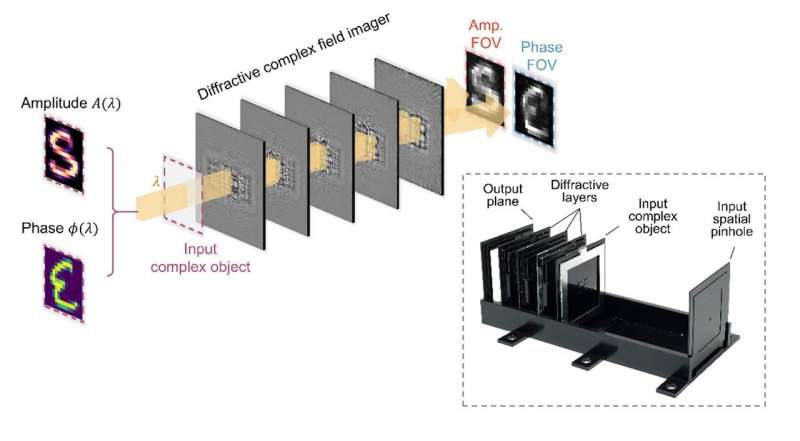This article has been reviewed according to Science X's editorial process and policies. Editors have highlighted the following attributes while ensuring the content's credibility:
fact-checked
peer-reviewed publication
trusted source
proofread
New imager acquires amplitude and phase information without digital processing

Researchers at the University of California, Los Angeles (UCLA) have achieved a significant milestone in optical imaging technology. A new all-optical complex field imager has been developed, capable of capturing both amplitude and phase information of optical fields without the need for digital processing.
This innovation promises to revolutionize various fields, including biomedical imaging, security, sensing, and material science. The work is published in the journal Light: Science & Applications.
A paradigm shift in imaging
Traditional optical imaging technologies rely on intensity-based sensors that can only capture the amplitude of light, leaving out the crucial phase information. Phase information provides insights into structural properties such as absorption and refractive index distributions, which are essential for detailed sample analysis.
Current methods to capture phase information involve complex interferometric or holographic systems supplemented by iterative phase retrieval algorithms, resulting in increased hardware complexity and computational demand.
A team at UCLA, led by Professor Aydogan Ozcan, has developed a novel complex field imager that overcomes these limitations. This innovative device uses a series of deep learning-optimized diffractive surfaces to modulate incoming complex fields. These surfaces create two independent imaging channels that transform the amplitude and phase of the input fields into intensity distributions on the sensor plane. This approach eliminates the need for any digital reconstruction algorithms, simplifying the imaging process significantly.
The new complex field imager consists of spatially engineered diffractive surfaces arranged to perform amplitude-to-amplitude and phase-to-intensity transformations. These transformations allow the device to directly measure the amplitude and phase profiles of input complex fields. The imager's compact optical design spans approximately 100 wavelengths axially, making it highly integrable into existing optical systems.
The researchers validated their designs through 3D-printed prototypes operating in the terahertz spectrum. The experimental results showed a high degree of accuracy, with the output amplitude and phase channel images closely matching numerical simulations. This proof-of-concept demonstration highlights the potential of the complex field imager for real-world applications.
Applications and future prospects
This breakthrough in complex field imaging technology opens up a wide range of applications. In the biomedical field, the imager can be used for real-time, non-invasive imaging of tissues and cells, providing critical insights during medical procedures. Its compact and efficient design makes it suitable for integration into endoscopic devices and miniature microscopes, potentially advancing point-of-care diagnostics and intraoperative imaging.
In environmental monitoring, the imager can facilitate the development of portable lab-on-a-chip sensors for rapid detection of microorganisms and pollutants. Its portability and ease of use make it an ideal tool for on-site quantitative analysis, streamlining the process of environmental assessment.
The complex field imager also holds promise for industrial applications, where it can be used for the rapid inspection of materials. Its ability to capture detailed structural information without the need for bulky equipment or extensive computational resources makes it a valuable asset in quality control and material analysis.
The development of the all-optical complex field imager represents a significant advancement in the field of optical imaging. By enabling the direct capture of amplitude and phase information without digital processing, this technology simplifies the imaging process and broadens the scope of potential applications. As the research team continues to refine and expand upon their designs, the impact of this innovation is expected to grow, offering new opportunities for scientific research and practical applications across various fields.
More information: Jingxi Li et al, All-optical complex field imaging using diffractive processors, Light: Science & Applications (2024). DOI: 10.1038/s41377-024-01482-6
Journal information: Light: Science & Applications



















